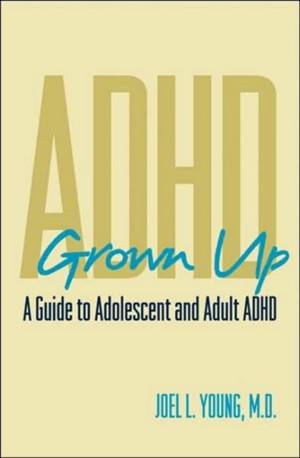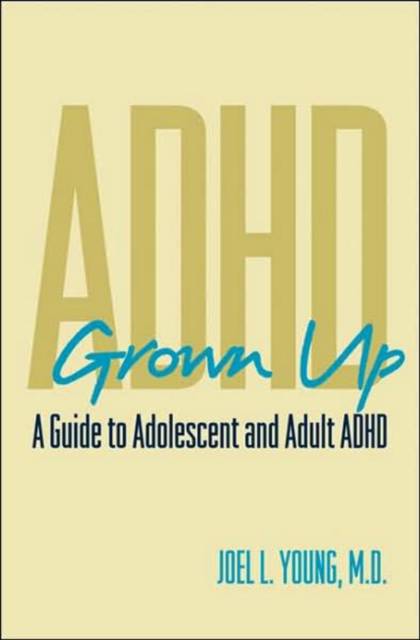
- Retrait gratuit dans votre magasin Club
- 7.000.000 titres dans notre catalogue
- Payer en toute sécurité
- Toujours un magasin près de chez vous
- Retrait gratuit dans votre magasin Club
- 7.000.0000 titres dans notre catalogue
- Payer en toute sécurité
- Toujours un magasin près de chez vous
Description
Currently, 6-9% of all children are diagnosed with ADHD and there has been an explosion in recent years in the discussion of ADHD-its prevalence, its diagnosis, its importance to parents and their children. Yet despite this awareness, many clinicians as well as the general public continue to under-appreciate the significance of ADHD as it manifests itself in adults.
What happens to all these ADHD kids when they grow up? ADHD isn't like a cold or the flu--it doesn't just go away all of the time. As a child grows and matures, it is possible that the symptoms lessen, and in some cases adults are able to overcome the disorder, but it doesn't usually just vanish on its own. At least 40-70% of those diagnosed with this disorder as kids will have it persist when they are adults; however, mental health professionals often overlook ADHD symptoms and continue calling their adult patients who suffer from it anxious or depressed, or diagnose them with a personality disorder. Family members may also consider adults with procrastination issues, inattentiveness, and distractibility lazy or malingering, when in fact they are suffering from ADHD.
Here Joel Young MD, who has been treating and researching ADHD for more than15 years, takes a comprehensive look at ADHD in adults. As an accurate diagnosis is essential to a patient's successful treatment, the book begins by detailing how clinicians can provide the most accurate ADHD diagnosis. Once established, the basic diagnostic process begins. This includes obtaining a careful medical history to rule out medical problems that may mimic the symptoms of ADHD, taking a psychiatric history and carefully considering any family or genetic history of medical and psychiatric problems. Some helpful tools used to evaluate quickly and comprehensively distressed patients are presented.
Comorbidities are extremely common among patients with ADHD. Emphasis in the book is placed on the most common ADHD comorbidities, including mood and anxiety disorders, bipolar disorder, oppositional defiant disorders, eating disorders and learning disabilities. The book also details the different types of ADHD that clinicians may encounter: ADHD (predominately hyperactive/impulsive subtype) is manifested in people who are hyperactive, and experience serious problems at work and at home. They are fidgety and impatient and may be the most commonly diagnosed adults. ADHD (predominately-inattentive subtype) manifests itself in patients who are typically, but not exclusively, female. As children, these women were inattentive and distractible, underperforming but not demonstrating overt behaviors typical of their hyperactive brethren. Their conditions may be complicated by factors like anxiety, depression, and fatigue. Even as adults, most clinicians overlook their symptoms.
Other chapters focus on diagnostic and treatment issues in specific populations: adolescents and common adolescent mindsets; women with ADHD; substance abuse; psychotherapy and coaching as treatments and medications. The medications chapter will review the use of antidepressant and mood stabilizing medications taken in concert with stimulants or non-stimulants, and other medication combinations need for conditions comorbid with ADHD. Finally, the author concludes by presenting findings that self-referred patients with fibromyalgia and chronic fatigue syndrome have high rates of ADHD. Young proposes that extreme distractibility may intensify the patient's pain perception.
Overall this book provides clinicians and family members with a concise yet comprehensive overview of the many issues associated with ADHD throughout adolescence and adulthood.
Spécifications
Parties prenantes
- Auteur(s) :
- Editeur:
Contenu
- Nombre de pages :
- 344
- Langue:
- Anglais
Caractéristiques
- EAN:
- 9780393704686
- Date de parution :
- 01-01-07
- Format:
- Livre relié
- Format numérique:
- Genaaid
- Dimensions :
- 156 mm x 243 mm
- Poids :
- 662 g

Les avis
Nous publions uniquement les avis qui respectent les conditions requises. Consultez nos conditions pour les avis.






